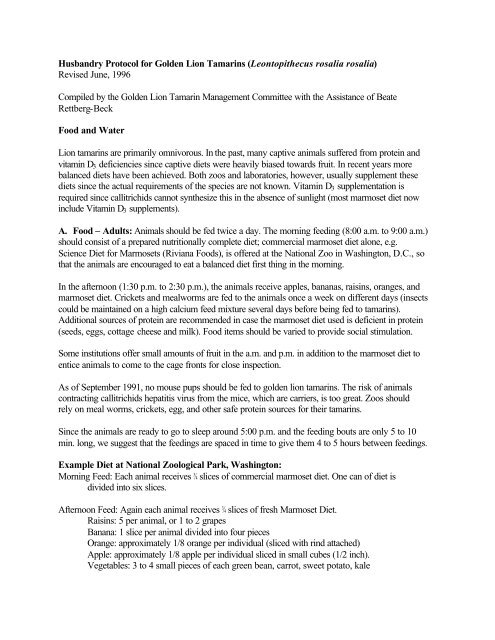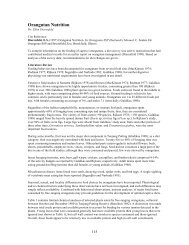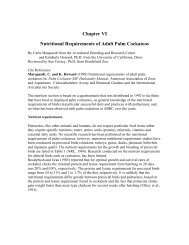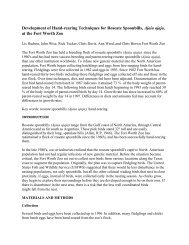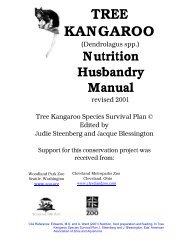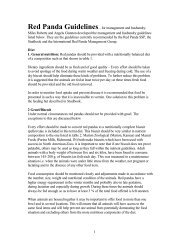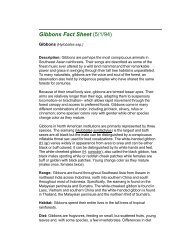Husbandry Protocol For Golden Lion Tamarins - Nutrition Advisory ...
Husbandry Protocol For Golden Lion Tamarins - Nutrition Advisory ...
Husbandry Protocol For Golden Lion Tamarins - Nutrition Advisory ...
You also want an ePaper? Increase the reach of your titles
YUMPU automatically turns print PDFs into web optimized ePapers that Google loves.
<strong>Husbandry</strong> <strong>Protocol</strong> for <strong>Golden</strong> <strong>Lion</strong> <strong>Tamarins</strong> (Leontopithecus rosalia rosalia)<br />
Revised June, 1996<br />
Compiled by the <strong>Golden</strong> <strong>Lion</strong> Tamarin Management Committee with the Assistance of Beate<br />
Rettberg-Beck<br />
Food and Water<br />
<strong>Lion</strong> tamarins are primarily omnivorous. In the past, many captive animals suffered from protein and<br />
vitamin D3 deficiencies since captive diets were heavily biased towards fruit. In recent years more<br />
balanced diets have been achieved. Both zoos and laboratories, however, usually supplement these<br />
diets since the actual requirements of the species are not known. Vitamin D3 supplementation is<br />
required since callitrichids cannot synthesize this in the absence of sunlight (most marmoset diet now<br />
include Vitamin D3 supplements).<br />
A. Food – Adults: Animals should be fed twice a day. The morning feeding (8:00 a.m. to 9:00 a.m.)<br />
should consist of a prepared nutritionally complete diet; commercial marmoset diet alone, e.g.<br />
Science Diet for Marmosets (Riviana Foods), is offered at the National Zoo in Washington, D.C., so<br />
that the animals are encouraged to eat a balanced diet first thing in the morning.<br />
In the afternoon (1:30 p.m. to 2:30 p.m.), the animals receive apples, bananas, raisins, oranges, and<br />
marmoset diet. Crickets and mealworms are fed to the animals once a week on different days (insects<br />
could be maintained on a high calcium feed mixture several days before being fed to tamarins).<br />
Additional sources of protein are recommended in case the marmoset diet used is deficient in protein<br />
(seeds, eggs, cottage cheese and milk). Food items should be varied to provide social stimulation.<br />
Some institutions offer small amounts of fruit in the a.m. and p.m. in addition to the marmoset diet to<br />
entice animals to come to the cage fronts for close inspection.<br />
As of September 1991, no mouse pups should be fed to golden lion tamarins. The risk of animals<br />
contracting callitrichids hepatitis virus from the mice, which are carriers, is too great. Zoos should<br />
rely on meal worms, crickets, egg, and other safe protein sources for their tamarins.<br />
Since the animals are ready to go to sleep around 5:00 p.m. and the feeding bouts are only 5 to 10<br />
min. long, we suggest that the feedings are spaced in time to give them 4 to 5 hours between feedings.<br />
Example Diet at National Zoological Park, Washington:<br />
Morning Feed: Each animal receives ¾ slices of commercial marmoset diet. One can of diet is<br />
divided into six slices.<br />
Afternoon Feed: Again each animal receives ¾ slices of fresh Marmoset Diet.<br />
Raisins: 5 per animal, or 1 to 2 grapes<br />
Banana: 1 slice per animal divided into four pieces<br />
Orange: approximately 1/8 orange per individual (sliced with rind attached)<br />
Apple: approximately 1/8 apple per individual sliced in small cubes (1/2 inch).<br />
Vegetables: 3 to 4 small pieces of each green bean, carrot, sweet potato, kale
Crickets (6 per animal): Wednesday and Friday<br />
Mealworms (8 per animal): 3 to 4 times per week<br />
Hard boiled egg: 2 times per week (1/4 of an egg per animal)<br />
If diet needs to be supplemented, add cottage cheese or hard boiled egg. This will increase protein<br />
content. Crickets and mealworms are offered alive.<br />
Diets at the Frankfurt Zoological Park, West Germany:<br />
8:00 a.m. Some crickets vitaminized with vitamin B-complex (2 times per week with Cafrubiase).<br />
If no crickets are available, they are offered pieces of bananas.<br />
9:30 a.m. ca. 25-40 ml monkey pap per animal with the following ingredients:<br />
1 1 boiled porridge<br />
250 g g curds (low fat-value)<br />
6 raw eggs<br />
75 g animal proteins (concentrated)<br />
210 g concentrated plant protein mixture<br />
210 g children food mixture<br />
250 g dextrose<br />
2 tablespoons of honey<br />
140 g mineral salt mixture<br />
35 g ROVOMIX<br />
30 g dry yeast or barm<br />
= mixed with ca. 1.5 liter, it makes about 4 liter of pap<br />
Vitamin supplements:<br />
1 teaspoon B-complex or<br />
1 teaspoon Vitacombex or<br />
20 drops Multimulsin or<br />
1 ampule Frubiase Calcium f.<br />
11:30 a.m. About 6 g monkey dumpling per animal with the following ingredients:<br />
2 boiled eggs<br />
1 banana<br />
1-2 carrots<br />
1 apple<br />
All these ingredients should be reduced into small pieces and mixed with:<br />
70 g concentrated animal protein<br />
90 g concentrated plant protein<br />
150 g dextrose<br />
70 g mineral salt mixture<br />
20 g ROVIMIX<br />
30 g yeast or bram<br />
50 g germinated wheat<br />
110 g wheat bran
2 tablespoon honey<br />
All ingredients, if kneaded with wheat bran and children food mixture, give a rough crumbly mixture.<br />
Per animal ca. 120 g small pieces of fruit and vegetables as available (orange, lemon, apple, banana,<br />
cherry, grapes, peaches, kiwi, onion, tomatoes, carrots).<br />
Dried Fruits (raisins and bananas)<br />
About 2 g cattle heart cut into small pieces<br />
About 4 g boiled egg.<br />
1:00 p.m. Offer tea and remove the pap.<br />
4:00 p.m. Feeding live insects, per animal:<br />
2-3 grasshoppers, or<br />
6-8 crickets, or<br />
6-8 wax moth<br />
Diets at Jersey Wildlife Preservation Trust:<br />
These animals are kept in various pairs, groups, and families, and are fed together from shared dishes<br />
(1 dish per 2-3 animals) with some food items being offered on an individual basis. There are 3 meals<br />
each day. Adult Leontopithecus weigh 600-700 g. This feeding program shows an average quantity<br />
for a Saguinus sp.<br />
9:00 a.m. Prepared marmoset mixture 30 g<br />
12:00 noon apple 45 g<br />
orange 20 g<br />
banana 15 g<br />
carrot, cucumber,<br />
potato, or celery 10 g<br />
plus 2 additional fruits in season 15 g<br />
Plus a selected high-protein food on rotation:<br />
Days 1 & 5 hard-boiled egg in shell 8 g<br />
Days 2 & 4 proprietary catfood, e.g. Kit-e-Kat 13 g<br />
Day 3 calfmeat (heart and liver) 7 g<br />
Day 6 hard (cheddar) cheese 5 g<br />
with yogurt 1 tsp.<br />
Day 7 unshelled peanuts & Marmoset jelly 5 g<br />
4:00 p.m. A selected food item on rotation:<br />
Day 2, 3, 5, 7 brown bread soaked in raw egg<br />
Day 6 mealworms or other insects as available.<br />
e.g. crickets, locust, waxmoth larvae.
All fruits and vegetables are cut into small cubes and mixed loosely together. Actual quantities given<br />
will vary according to species, size of group, and the composition and general condition of groups.<br />
Vitamin Supplements:<br />
Vitamin E (Rovimix) once daily in second feed, 5 mg per animal<br />
Vitamin D3 (Rovimix) occasionally to individuals deprived of access to sunlight through illness,<br />
quarantine, adverse weather; 2500 i.u. each, weekly<br />
Vitamin B12 (Cytacon) once weekly in the marmoset mixture; 2 ml each<br />
Note: Lactating females receive condensed milk (diluted 1:10 with water) for 7 – 14 days post-partum<br />
at a rate of 50 ml/day. This is continued up to weaning age around 6-8 weeks on alternate days only.<br />
Marmoset mixture:<br />
This mixture has been devised to increase the palatability of the Mazuri New World Primate pellet<br />
that forms the basis for the first meal of the day. The mixture is prepared by soaking primate pellets<br />
in an equal volume of water and mixing this with ¾ loaf of crumbled brown bread, high protein baby<br />
cereal and golden syrup. The mixture should sit for several hours to ensure softening of the pellets,<br />
and it is therefore made up the night before feeding and stored in a cool place.<br />
An average composition of the mixture is:<br />
Mazuri New World Primate Pellets 750 g<br />
Water 830 ml<br />
Crumbled brown bread 255 g<br />
Baby cereal (Boots’ 30% protein) 40 g<br />
<strong>Golden</strong> syrup (2 tablespoons) 45 g<br />
S.D.S. Marmoset Jelly:<br />
This is a high protein, high energy food that is prepared by dissolving a powder and a flavor premix<br />
in hot water and allowing it to set. The resultant gel is cut into small cubes and offered to specimens<br />
once weekly. (<strong>For</strong> more details, contact the National Zoo or the Jersey Zoo).<br />
Reintroducing golden lion tamarins back into the wild has shown us that feeding whole fruits and<br />
eggs is stimulating and a challenge to problem solving for the animals. (Examples: whole bananas for<br />
a family group once a week, whole oranges with a small hole cut into the rind, whole papaya hung<br />
from a branch, bird eggs in a nest, mealworms hidden in rotten logs, crickets hidden in a bromeliad,<br />
etc.). Caution needs to be taken that there is not too great a reduction in the consumption of the main,<br />
nutritionally complete diet; be it canned, self prepared or pellets.<br />
B. Water: Fresh water provided in crocks, ponds or water bottles should be available at all times.<br />
Food and water dishes should be sanitized daily to prevent build-up, especially Pseudomonas.<br />
C. Feeding Behavior: Food sharing and stealing is common within family groups and serves to teach<br />
young about important food items.
D. Additional Comments on Food and Feeding: Certain animals may get diarrhea periodically.<br />
Temporary restriction to only the Science Diet Marmoset Ration may clear up the problem. If animals<br />
refuse the prepared diet or concentrate on fruit, hand feeding with nutritious foods that are preferred<br />
may initiate proper feeding again. A drop in food intake must be carefully watched. Oral medicines<br />
may be hand-fed to individuals in favorite foods like bananas or grapes.


